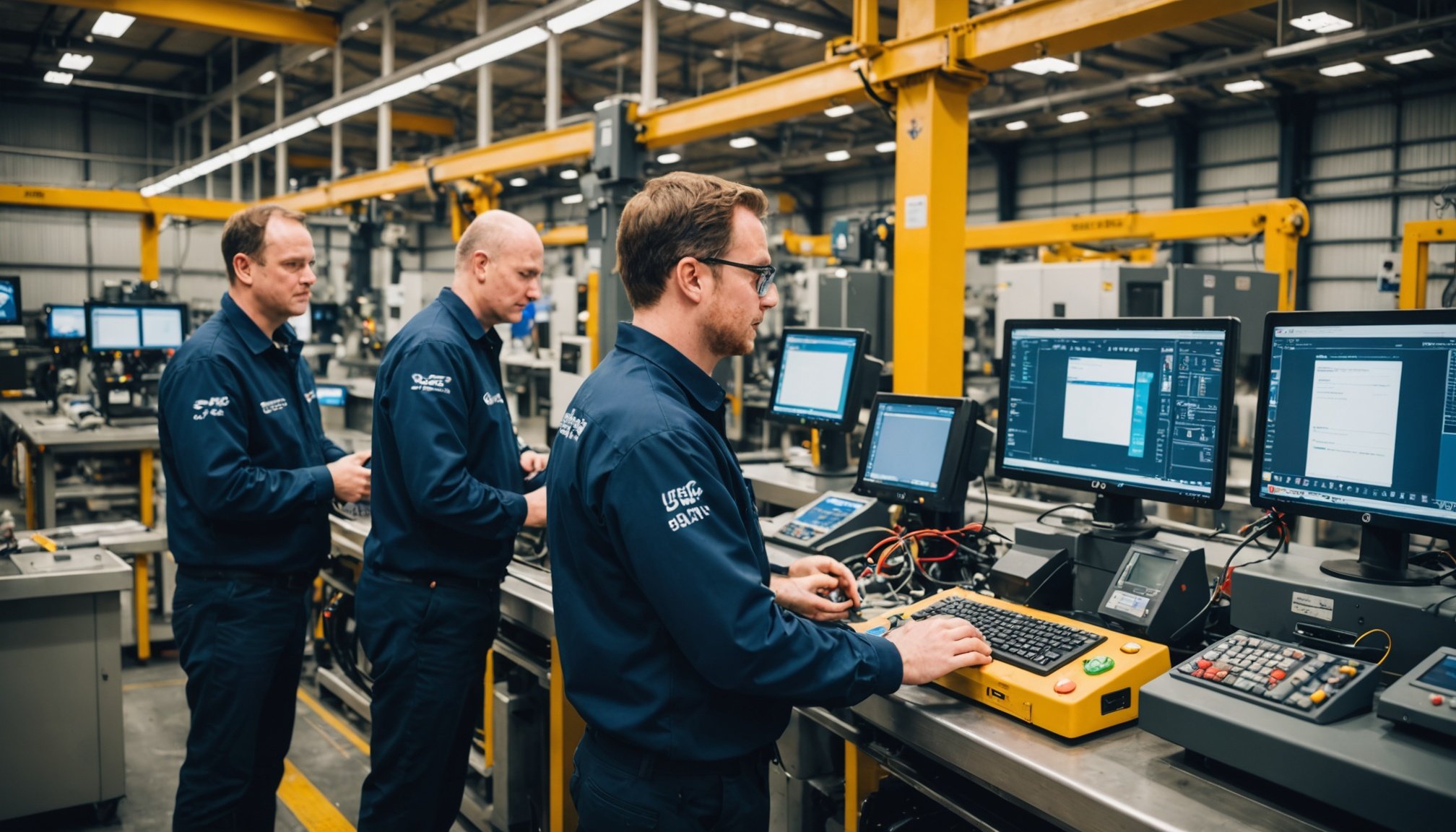Overview of IoT in UK Manufacturing
The UK manufacturing landscape is undergoing a transformative phase, significantly influenced by the integration of the Internet of Things (IoT). IoT in manufacturing involves interconnecting diverse devices and systems to enhance communication, data collection, and process automation, thereby revolutionising modern manufacturing.
In recent years, the UK’s manufacturing sector has been adopting IoT technologies to remain competitive and boost productivity. The potential of IoT lies in its ability to address complex operational challenges, optimise machinery efficiency, and enable real-time monitoring. As traditional manufacturing continues to evolve, the role of IoT becomes more prominent due to its proven value in enhancing connectivity and enabling smarter production processes.
Also read : Transforming UK Logistics: Harnessing Blockchain Innovations for Unprecedented Supply Chain Clarity
IoT trends are pivotal in shaping the future of UK manufacturing. Current trends include the increased adoption of sensors and embedded systems that provide insights into machinery performance and product quality. This trend is leading to data-driven decision-making, improving operational efficiency. Moreover, developments in artificial intelligence and machine learning are paving the way for predictive analytics, which is crucial for preemptive maintenance and reducing downtime. Embracing these IoT advancements can steer the UK manufacturing industry towards elevated operational standards and sustainability.
Benefits of IoT Innovations
The integration of IoT in manufacturing offers several significant benefits, including enhanced operational efficiency and cost reduction. By leveraging IoT technologies, manufacturers can collect real-time data, which is vital for making informed decisions, reducing downtime, and streamlining operations. This efficiency results in lower operational costs, enabling businesses to allocate resources more effectively.
Also to see : Transforming the Restaurant Experience: The Impact of Digital Menus on Customer Satisfaction in UK Dining
IoT benefits also extend to enhancing productivity. The interconnectivity between devices facilitates seamless communication and automation, increasing overall production output. For example, automated systems can adjust production flows dynamically based on real-time data analytics, ensuring optimal utilisation of resources and minimising waste.
Furthermore, the role of IoT in real-time data analytics cannot be overstated. By providing insights into various operational processes, manufacturers can preemptively address potential issues before they escalate, thus avoiding costly disruptions. The ability to monitor processes continuously allows businesses to anticipate changes in demand and adjust production schedules accordingly. This proactive stance not only boosts productivity but also results in significant time and cost savings.
In summary, IoT benefits are pivotal for achieving cost-effective and efficient manufacturing processes, positioning companies to adapt swiftly to market demands and technological advancements.
Case Studies of IoT Adoption in UK Manufacturing
Exploring case studies in UK manufacturing unveils how IoT is transforming operations. Let’s delve into three remarkable success stories.
Company A: Enhancing Production Efficiency
At Company A, IoT implementation has significantly boosted production efficiency. By incorporating interconnected sensors on the production line, the company monitors machinery performance in real-time. Immediate feedback loops ensure optimal operations, thereby increasing output and reducing waste.
Company B: Reducing Maintenance Downtime
Company B’s IoT strategy has successfully tackled maintenance challenges. Utilising predictive maintenance technology, the firm anticipates equipment failures before they occur. As a result, downtime has decreased, operational continuity is maintained, and repair costs have dropped. This foresight, enabled by data analytics, underscores IoT’s impact on maintenance.
Company C: Optimizing Supply Chain Management
For Company C, IoT has revolutionised supply chain management. Tracking systems provide visibility into product flow, enabling timely adjustments to distribution networks. The outcome? Improved delivery schedules and inventory management, leading to customer satisfaction increases. Furthermore, the IoT-driven insights aid in planning and resource allocation.
These success stories highlight how companies leverage IoT technologies for measurable improvements. The lessons emphasise the importance of adapting IoT to specific needs and ensure that IoT implementation aligns with broader company goals.
Challenges of Implementing IoT Solutions
The journey of integrating IoT in manufacturing within the UK manufacturing landscape is not without its hurdles. One primary challenge revolves around overcoming implementation barriers. Many manufacturers face difficulties in integrating IoT with their existing systems and processes. This integration complexity can lead to significant delays and increased costs.
Additionally, data security and privacy concerns are paramount. The interconnected nature of IoT devices increases vulnerability to cyber threats, which can jeopardise sensitive operational data. Addressing these risks involves robust cybersecurity measures, which can be resource-intensive.
Moreover, there’s the challenge of adapting to IoT trends, where technological advancements demand flexibility and ongoing updates to remain competitive. This often requires a cultural shift towards embracing continuous innovation, which some organisations may find daunting.
Furthermore, the skill gap poses another significant challenge. As IoT implementation requires new competencies, manufacturers are compelled to upskill their workforce. Without adequately trained personnel, leveraging IoT’s full potential remains elusive.
Lastly, costs associated with new technology adoption also present challenges. Initial investments in IoT infrastructure, while eventually beneficial, can be prohibitive for smaller manufacturers trying to keep pace with larger industry players.
Steps to Successfully Implement IoT Innovations
IoT implementation requires a clear and strategic approach to achieve success in the UK manufacturing landscape. Establishing a robust IoT implementation strategy is vital. Firstly, manufacturers should conduct a comprehensive needs assessment to identify specific operational areas that would benefit from IoT technologies. Aligning these needs with business objectives ensures a targeted and effective implementation.
Another essential component is the upskilling and training of the workforce. As IoT introduces new technologies, employees must be equipped with the necessary skills to manage and maintain these systems. This can be achieved through workshops, training programs, or collaborations with educational institutions.
Collaboration with technology partners and vendors is crucial for accessing the latest best practices and innovations. Partners can offer valuable insights, helping manufacturers to tailor IoT solutions effectively to their specific contexts. Establishing strong vendor relationships also aids in addressing technical hurdles swiftly, ensuring seamless implementation.
Additionally, setting clear guidelines and frameworks for IoT deployment helps streamline processes and mitigate risks. Emphasising data security and integrating robust privacy measures from the start is paramount to safeguarding manufacturing operations. With careful planning and execution, IoT can be successfully integrated, enhancing the manufacturing process in the long run.
Future Trends of IoT in UK Manufacturing
As IoT continues to redefine the UK manufacturing landscape, the focus is shifting towards its future trajectory. Emerging trends are poised to enhance factory intelligence and innovation further. One significant development is the growth of predictive maintenance, which enables early detection of equipment malfunctions. This foresight empowers manufacturers to schedule maintenance proactively, minimizing unexpected downtime.
In the coming decade, IoT’s role will expand as industries transition towards smart factories. The evolving landscape will witness interconnected systems and devices making autonomous decisions, optimizing production flows with minimal human intervention. This shift promises heightened efficiency, illustrating IoT’s potential to revolutionize traditional manufacturing processes.
Future IoT trends also foresee advancements in data analytics and artificial intelligence. These technologies will allow for even more precise predictions and adaptive manufacturing environments, where machines learn from data patterns to enhance their performance. Ultimately, as IoT matures, we can expect an increased emphasis on sustainable practices, leveraging intelligent systems to minimize waste and energy consumption.
As these trends unfold, the UK manufacturing sector will not only become more efficient but also more resilient to market fluctuations, paving the way for a robust industrial future.











